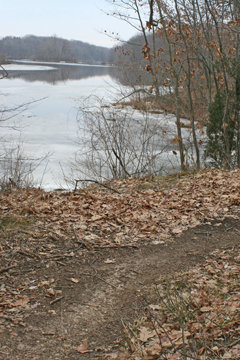
At an obscure trailhead hidden behind a backyard in southwest Lansing, a laminated card is crudely duct taped to a fence pole: “No motorized vehicles or hunting in parks.” On a Saturday afternoon in late February, hundreds of deer tracks and a few raccoon prints were the only signs of life on the muddy, unimproved trail until my boots marked a few small steps for mankind.
Granted, they didn’t spare the duct tape, but this is not a pricey project. Fine Park is one of three deceptively humble gateways to Lansing’s newest hidden park treasure: six miles of riverfront mountain biking and walking trails that hug a gorgeous bend of the Grand River west of Waverly Road.
You can get to trails from Fulton and Hunter’s Ridge parks to the north, but none of the trailheads announce the prize: a near-wilderness ramble through woods, high bluffs and river lowlands that feels more like the rugged Au Sable in northern Michigan than flat old Lansing.
At a community meeting earlier this month, Lansing Parks and Recreation Director Brett Kaschinske announced a plan to connect all the trails and add a bridge across the Grand River that would hook up to six more trails in Anderson Park and the glories of the Woldumar Nature Center.
“It’s beautiful, it’s waterfront, it’s in an urban area. It’s huge,” Kaschinske said.
Add Fine Park’s 36 acres to Fulton’s 26 and 28 acres in Hunter’s Ridge, and you get nearly 100 acres of contiguous parkland.
Kaschinske described the dirt trail system as “a sort of squiggly figure eight with four miles on the bottom and two miles on top.”
A short connection between the two halves of the Figure Eight is planned for this year, pending review by the state’s Department of Environmental Quality.
The city has also applied to the state’s Department of Natural Resources to buy a crucial nine riverfront acres, now owned by the Lansing Boat Club but not in use, that would help hook everything together.
The grant is a shoo-in because it’s ranked No. 1 in this year’s DNR evaluation, Kaschinske said.
For years, local residents have been taking walks, and mountain bikers have been rolling up and down these bluffs. The Mid- Michigan Mountain Biking Association agreed to blaze and maintain the trails, which it’s already been doing.
The trail system is a model exercise in the modern civic art of making bricks without straw, or, more to the point, parks without city funds. In 2009, the city bought the 28- acre Hunter’s Ridge at the north end of the riverside strip of parkland, using a $750,000 grant from the DNR. The property was valued at about a million. The sellers donated the city’s $250,000 share.
Councilwoman Kathie Dunbar said the acquisition was a coup in an era when Lansing Mayor Virg Bernero has backed a series of plans to sell off parkland.
The trail system would add a new statewide attraction to an under-served recreation field: mountain biking.
“We don’t have mountain biking in Lansing,” Kaschinske said. “You have to go to Burchfield Park in Holt or Anderson Park in Delta Township.”
Anderson Park is already a big mountain bike attraction. You can go to YouTube and vicariously ride all of the park’s loops via smartphone cameras. And it’s very close to the Fulton-Fine-Hunter's Ridge system. The prospect of hooking it all up has a lot of people excited.
“Talk about connectivity — we can put a little bridge over the river, connect these two, and now you’re out to Old Lansing Road through Anderson Park, near Woldumar Nature Center,” Kaschinske said. Another DNR grant application, for the bridge, is in the works.
Kaschinske compared the trail’s lopsided coolness-to-obscurity ratio to that of Crego Park, on the city’s east side. The 200-acre park with a lake was dormant for 28 years until it was brought back to life after an environmental cleanup and improvements were completed in 2014. The Crego project also relied mainly on state DNR funds.
“Everyone is going to say, ‘I never knew this was back here,’” Kaschinske said. “I’m already hearing that.”
Nancy Krupiarz, director of the Michigan Trails and Greenways alliance, said the connected trail “would definitely put us on the map for mountain biking.”
“It’s also great for walking and wildlife viewing,” she said.
Kaschinske sees no reason hikers and mountain bikers can’t share the system.
“Delta Township and Ingham County have proven success that bikes and pedestrians can share the same pathway,” he said.
Dunbar loves the three-story observation deck on the bluff at Fulton Park.
“You can see fish jumping, geese, ducks — you would never know you’re in the city,” she said.
Support City Pulse - Donate Today!
Comments
No comments on this item Please log in to comment by clicking here